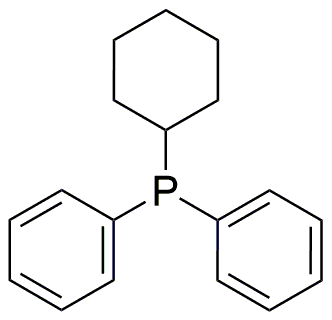Cyclohexyldiphenylphosphine is widely utilized in research focused on:
- Organometallic Chemistry: This compound serves as a ligand in various metal complexes, enhancing catalytic reactions in organic synthesis, particularly in cross-coupling reactions.
- Pharmaceutical Development: Its properties allow for the development of new drugs, especially in creating phosphine-based compounds that can modulate biological activities effectively.
- Material Science: Used in the synthesis of advanced materials, it contributes to the development of polymers and coatings that require specific chemical properties for durability and performance.
- Environmental Chemistry: It plays a role in the remediation of pollutants, acting as a reagent in processes that help detoxify hazardous substances in the environment.
- Research Laboratories: Commonly employed in academic and industrial labs for various synthetic pathways, it provides researchers with a versatile tool for exploring new chemical reactions and applications.
General Information
Properties
Safety and Regulations
Applications
Cyclohexyldiphenylphosphine is widely utilized in research focused on:
- Organometallic Chemistry: This compound serves as a ligand in various metal complexes, enhancing catalytic reactions in organic synthesis, particularly in cross-coupling reactions.
- Pharmaceutical Development: Its properties allow for the development of new drugs, especially in creating phosphine-based compounds that can modulate biological activities effectively.
- Material Science: Used in the synthesis of advanced materials, it contributes to the development of polymers and coatings that require specific chemical properties for durability and performance.
- Environmental Chemistry: It plays a role in the remediation of pollutants, acting as a reagent in processes that help detoxify hazardous substances in the environment.
- Research Laboratories: Commonly employed in academic and industrial labs for various synthetic pathways, it provides researchers with a versatile tool for exploring new chemical reactions and applications.
Documents
Safety Data Sheets (SDS)
The SDS provides comprehensive safety information on handling, storage, and disposal of the product.
Product Specification (PS)
The PS provides a comprehensive breakdown of the product’s properties, including chemical composition, physical state, purity, and storage requirements. It also details acceptable quality ranges and the product's intended applications.
Certificates of Analysis (COA)
Search for Certificates of Analysis (COA) by entering the products Lot Number. Lot and Batch Numbers can be found on a product’s label following the words ‘Lot’ or ‘Batch’.
Numéro de catalogue
Numéro de lot/série
Certificates Of Origin (COO)
This COO confirms the country where the product was manufactured, and also details the materials and components used in it and whether it is derived from natural, synthetic, or other specific sources. This certificate may be required for customs, trade, and regulatory compliance.
Numéro de catalogue
Numéro de lot/série
Safety Data Sheets (SDS)
The SDS provides comprehensive safety information on handling, storage, and disposal of the product.
DownloadProduct Specification (PS)
The PS provides a comprehensive breakdown of the product’s properties, including chemical composition, physical state, purity, and storage requirements. It also details acceptable quality ranges and the product's intended applications.
DownloadCertificates of Analysis (COA)
Search for Certificates of Analysis (COA) by entering the products Lot Number. Lot and Batch Numbers can be found on a product’s label following the words ‘Lot’ or ‘Batch’.
Numéro de catalogue
Numéro de lot/série
Certificates Of Origin (COO)
This COO confirms the country where the product was manufactured, and also details the materials and components used in it and whether it is derived from natural, synthetic, or other specific sources. This certificate may be required for customs, trade, and regulatory compliance.


